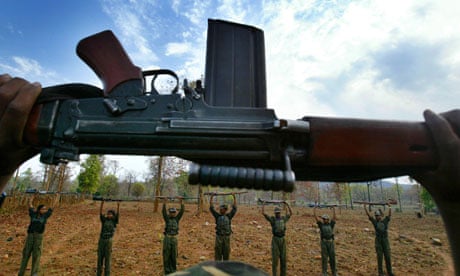The Maoist insurgency in India has its roots in a 1967 rural uprising in Naxalbari, a village in West Bengal, and in a simultaneous series of splits in the powerful Indian Communist party.
By the early 1970s the Indian state had crushed the first wave of agitation, led largely by university educated urbanites.
But violence has surged again with the unification of two extremist factions, the People's War Group, and the Maoist Communist Centre, which formed the Communist party of India (Maoist) in 2004.
The aim of the movement, according to Indian government officials, is the overthrow of the Indian state through a protracted armed campaign lasting many decades. The Maoists' own literature says their targets include "eco-imperialist exploitation" by multinational companies, and the "social oppression" of India's caste system.
Many of the Maoists' recruits are from India's marginalised tribal communities who have gained nothing from their country's recent economic growth. The group's leaders are largely educated and have urban backgrounds.
From their stronghold in the southern districts of the state of Chhattisgarh, the Maoists have been trying to expand operations into West Bengal. In all, there are believed to be several thousand hardcore Maoist fighters and many tens of thousands of active supporters. Most weapons are stolen from security forces or made in basic workshops. Some are bought on the black market.
The number of incidents relating to the insurgency has been rising, from 1,533 in 2004, to 2,239 last year. In 2009 586 civilians were killed, as well as 317 members of the security forces and 217 insurgents, according to the Indian government.
In April, 76 policemen were killed in an ambush. Only a handful in the cornered force escaped.
The Maoists have been able to establish "liberated zones" in parts of the south, centre and eastern regions of India where government authority is almost non-existent. The government says there are Maoists in a third of all districts in India, though many analysts believe their presence is often minimal.
Though the insurgents appear not to be a strategic threat to such a large country, their activity worries investors and advertises India's deep inequalities.
The Maoists have won the sympathy of many leading Indian intellectuals, including the writer and activist Arundhati Roy, who have been accused of ignoring the more unsavoury aspects of the Maoist campaigns, such as the kangaroo courts, killings of alleged "informers", and the civilian casualties.
Critics also say the Maoists do not physically attack the businesses they accuse of unfairly exploiting mineral resources but extort money from them instead.

